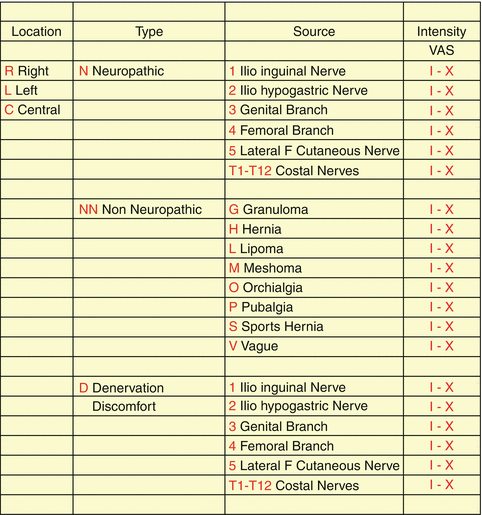Fig. 21.1.
Material: A ballpoint pen and three permanent markers, black for normal sensation (isoesthesia), red for pain or tenderness (hyperesthesia), and blue for anesthesia, numbness, or discomfort (hypoesthesia). Each point is evaluated and marked as follows: (a) A circle in black for those who have a similar sensation to the reference para-umbilical point. (b) A cross in red for those points where the patient feels pain and/or hypersensitivity. (c) A minus in blue for those points of anesthesia, hypoesthesia, or discomfort (superficial burning or numbness).
In all patients with chronic postoperative pain, dermatome mapping test (DMT) can be implemented using as reference a point one-inch lateral to the umbilicus contralateral to the region to be evaluated. With respect to this point, sequentially go from the superior iliac crest to the midline at a distance of no more than one inch between each point radially, continuing down to the upper third of the scrotum and penis for males, or the labia for women. Continue inferiorly to reach and evaluate the upper third of the thigh, including the anterior, lateral, and medial sides (Figs. 21.2, 21.3, 21.4, 21.5, 21.6, 21.7, 21.8, 21.9, 21.10, and 21.11).



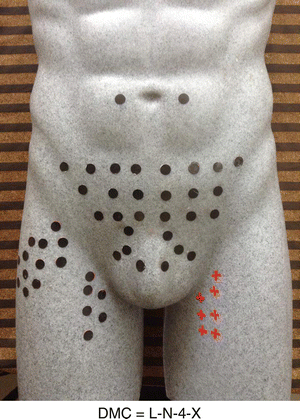
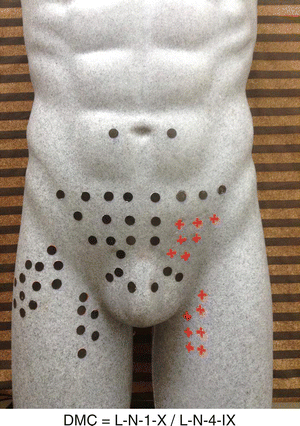
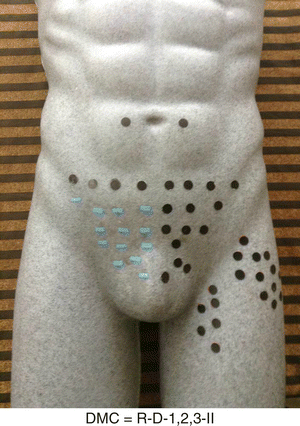
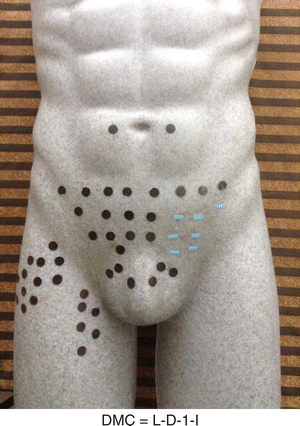
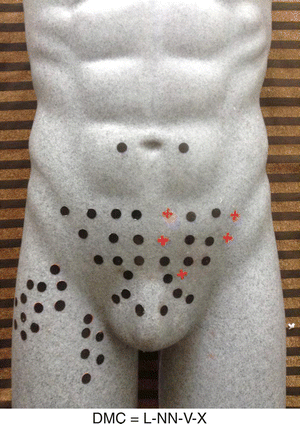
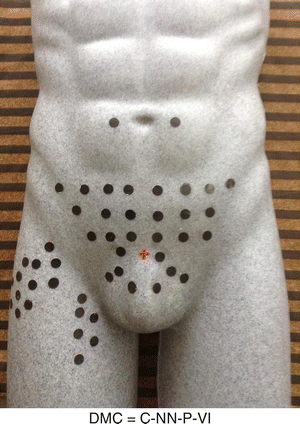


Fig. 21.2.
Dermatome mapping compatible with postoperative pain due to right ilioinguinal nerve involvement. DMC Dermatome Mapping Classification.

Fig. 21.3.
Dermatome mapping compatible with postoperative pain due to left iliohypogastric nerve involvement.

Fig. 21.4.
Dermatome mapping compatible with postoperative pain due to left genital branch involvement. This injury occurs mainly when the round ligament is severed or plugs are placed in the internal ring where this branch emerges.

Fig. 21.5.
Dermatome mapping compatible with postoperative pain due to left femoral branch involvement. This injury occurs mainly in patients approached laparoscopically.

Fig. 21.6.
Dermatome mapping compatible with postoperative pain due to left ilioinguinal nerve and left femoral branch involvement. This injury occurs mainly in patients approached laparoscopically.

Fig. 21.7.
Dermatome mapping compatible with postoperative denervation, numbness, or discomfort after a successful right triple neurectomy. As a follow-up to chronic postoperative pain assessment.

Fig. 21.8.
Dermatome mapping compatible with postoperative denervation, numbness, or discomfort due to successful selective neurectomy of the left ilioinguinal nerve. As a follow-up to chronic postoperative pain assessment.

Fig. 21.9.
Dermatome mapping compatible with a non-neuropathic or nociceptive VAGUE postoperative etiology of pain because it does not follow the pattern of a dermatome. This is probably the case of a simulator due to malingering, conversion, or other non-anatomic pathology. In these scenarios, dermatome mapping may be repeated a week later and photographed, with expectations of a complete different pattern.

Fig. 21.10.
Dermatome mapping compatible with a non-neuropathic or nociceptive postoperative PUBALGIA.

Fig. 21.11.
Dermatome mapping compatible with a non-neuropathic or nociceptive postoperative right ORCHIALGIA.
Once the dermatome mapping is completed, proceed to photograph the area and integrate this into the clinical record in order to have an objective view of this event. We can follow up with subsequent mapping to compare with previous DMTs in cases of vague pain scenarios or in preoperative versus postneurectomy pain assessments after quadruple, triple, or selective neurectomy.
Dermatome Mapping Classification
Traditionally, in the era when recurrence was our main concern, chronic postoperative inguinal pain had been referred to using the general term “inguinodynia” for all possible types of inguinal pain manifestations. However, the variation of clinical presentations and etiologies necessitates that we broaden and deepen our understanding of this complex condition [16]. Primarily, it is important to establish the origin of the pain and to classify the location and type of pain that we are dealing with: neuropathic (follows the pattern of a dermatome of specific nerve trunks), nociceptive (non-neuropathic), or paresthesias (denervation or discomfort due to incidental or therapeutic neurectomy).
Subsequently, we must determine the specific source of pain. That is, to establish which nerve or multiple nerve trunks are involved, and at the same time determine if the source of pain is non-neuropathic (meshomas, orchialgia, pubalgia, or vague) or some other mechanism when the nerve trunks are clearly preserved.
Finally, it is imperative to have a record of how the intensity of pain is perceived by the patient. For this purpose, the visual analogue scale (VAS) is used in conjunction with this classification system.
We reported the original Dermatome Mapping Classification in 2009 [9]; the updated 2015 DMC is presented in (Fig. 21.12) with respect to the pre- and postoperative evaluations of patients with chronic postoperative pain. Currently, we are updating the DMC regularly, expanding it, for example, not only to evaluate the inguinal region but also to consider thoracic nerves for cases when postoperative pain occurs in the abdominal region due to injury or entrapment of thoracic nerves during an inguinal laparoscopic surgery, or when using transfascial sutures, for instance, in the Rives or laparoscopic techniques. We have also modified the DMC to include Dr Chen’s contribution of the term “vague” for nonspecific situations, subjective inconsistencies, or patients simulating pain that had previously been termed “faking.”
